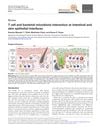Search
forLearn
5 / 8 resultslearn Neem Oil
natural substance from Neem tree with medicinal and pesticidal properties
learn Thymosin Beta 4
learn Overview
learn Caffeine
the stimulant you know and love can be used topically to stimulate hair
Research
5 / 1000+ resultsresearch TCF/Lef1-Mediated Control of Lipid Metabolism Regulates Skin Barrier Function
TCF/Lef1 is essential for skin barrier function by regulating lipid metabolism.
research Dynamics of Hair Follicle Morphogenesis and Skin Homeostasis
Hair follicle development involves specific cells and genes, crucial for understanding severe skin diseases like harlequin ichthyosis.

research T Cell and Bacterial Microbiota Interaction at Intestinal and Skin Epithelial Interfaces
T cells and bacteria in the gut and skin help maintain health and protect against disease.
research A Keratin Scaffold Regulates Epidermal Barrier Formation, Mitochondrial Lipid Composition, And Activity
Keratin is crucial for skin barrier formation and affects mitochondrial function.

research Deficiency of the Human Cysteine Protease Inhibitor Cystatin M/E Causes Hypotrichosis and Dry Skin
Lack of cystatin M/E causes thin hair and dry skin.
Community Join
5 / 220 resultscommunity Dutasteride absolutely nukes hair DHT
Dutasteride significantly reduces DHT levels, potentially more effectively than finasteride, and is used to treat hair loss. Some users report side effects like reduced libido and mood changes, while others experience hair regrowth and increased testosterone.
community What is the real impact of dutasteride on neurosteroids? A little review of 2 scientific datas
Dutasteride at 0.5 mg/day does not significantly alter allopregnanolone levels, but higher doses (2.5 mg/day) do. Dutasteride may also have anti-neuroinflammatory effects, but the impact on neurosteroids is still debated.
community Keratin microspheres - breakthrough
A gel of keratin microspheres promotes hair follicle growth, showing similar effectiveness to minoxidil in mice. The treatment activates hair growth pathways and reduces inflammation, with potential applications in drug delivery for hair-related disorders.
community Minoxidil alternative with a week long half-life? Why isn’t it possible?
This conversation discussed the potential for a hair loss treatment alternative to minoxidil, with many users debating the economic and health implications of such an option. Some suggested that finasteride could be used as an alternative, while others argued that this would ultimately not benefit pharmaceutical companies due to their reliance on planned obsolescence.
community Finasteride - impact on Neurosteroids, which yes, \are important and not a garbage hormone
Finasteride may affect neurosteroids, impacting mood and sexual function, with varied user experiences. Some report side effects like depression and sexual dysfunction, while others find it effective for hair retention or prefer alternatives like Dutasteride or topical treatments.